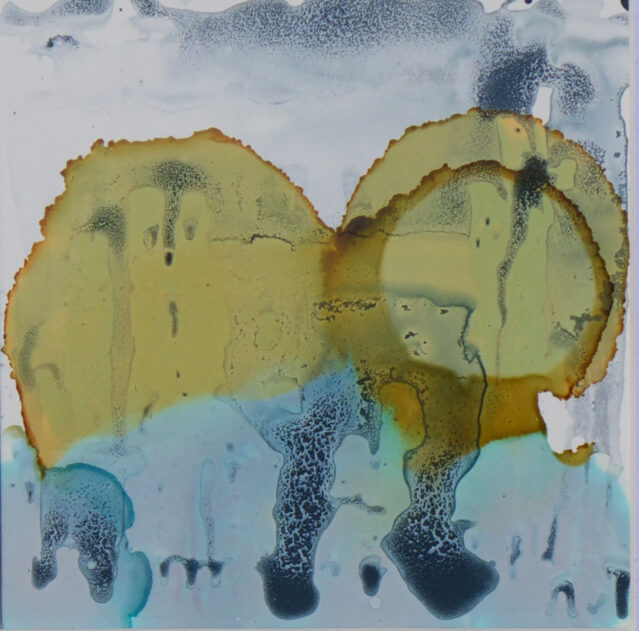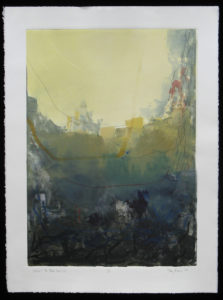 A good portion of my work is an intuitive response, rapidly laid down. This does not mean that the result seen on paper was altogether quick, though if you had watched this piece and others being birthed you might think so. What is visible is an end product of a long term simmering from my mind, spirit and body. The thoughts that collide toward and then into a particular working session, the prayers that have been raised and linger as I craft, and the arms and legs that labor this forward are mine.
A good portion of my work is an intuitive response, rapidly laid down. This does not mean that the result seen on paper was altogether quick, though if you had watched this piece and others being birthed you might think so. What is visible is an end product of a long term simmering from my mind, spirit and body. The thoughts that collide toward and then into a particular working session, the prayers that have been raised and linger as I craft, and the arms and legs that labor this forward are mine.
But I live influenced and challenged in time by much around me; and that can be seen here too. Of particular note is an apprehension regarding the mystery of beauty. Apprehension is a carefully selected word, I’ve found. For beauty is hard to grasp, and it is so much bigger than my very best catches. Sometimes it even involves some awe, like being at the edge of a chasm. Add to this: mourning over so much that is broken, while still aiming to step forward. And finally, every piece I make comes out from a long term feeding in the words of Scripture that continually ground, re-set and then lift me.
The word “Selah” for example is used often in the emotive expressions found in the book of the Hebrew Psalms. The word seems by its usage to be a deliberate stop for pondering. “Pause and think of that!” is how the Amplified version translates “Selah.” It is a call therefore from the penitent to other listeners. We stand together on ground that is broken, but some of us are looking up and leaning forward, yearning for His appearing.
I’ve been in Colorado this past week: looking up, peering over chasms, stepping forward and strategizing with others who care about getting most important things broadcast in most effective ways. In spare moments, I’ve also been updating some data on this site towards my book launch. In that process, I’ve seen some older posts, sort of buried here where the images need updating. Work in Progress. This post above was written in 2013, and I decided to re-post it now as the ideas are still so current.
This piece, “Selah” was made in 2008, was juried into a show for the monotype guild of New England’s 3rd National Exhibition in 2013, where it hung for a time at the Barrington Center for the Arts at Gordon College in Wenham, MA.
 Most all of us, living housed in our bodies, have functioning eyes. I love my eyes, and thank God for them; for with them I notice expression that tells me so much more than words. With them I can work with my hands at all kinds of things. With them I can apprehend beauty. And then with them I can lower my lids and signal the whole of my body to rest.
Most all of us, living housed in our bodies, have functioning eyes. I love my eyes, and thank God for them; for with them I notice expression that tells me so much more than words. With them I can work with my hands at all kinds of things. With them I can apprehend beauty. And then with them I can lower my lids and signal the whole of my body to rest.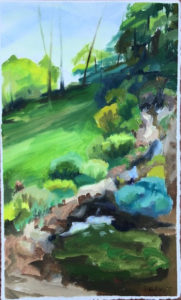 So I did a little exercise to test my “strike” resolve (see last post on the burger billboard). Abstractions made concrete, thoughts made real. The green has been shouting at me for attention, so I dug in to bring it home.
So I did a little exercise to test my “strike” resolve (see last post on the burger billboard). Abstractions made concrete, thoughts made real. The green has been shouting at me for attention, so I dug in to bring it home.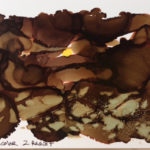
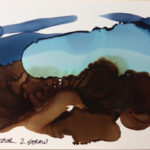 I am inserting here two little experiments with some inks for a workshop I’ll be conducting next week. Beginners will be introduced to some of the rationale behind abstraction’s promise. If some good work shows up from some of these craftsmen, I’ll be sure to post.
I am inserting here two little experiments with some inks for a workshop I’ll be conducting next week. Beginners will be introduced to some of the rationale behind abstraction’s promise. If some good work shows up from some of these craftsmen, I’ll be sure to post.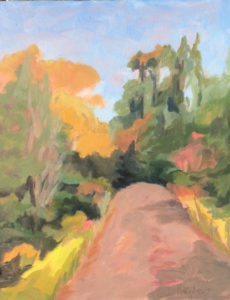 This week I went out on a trail where the leaves are turning, colors singing. The soil in this part of the state has a lot of iron in it. As a result, the dirt under my boots and all ahead of me is an unremarkable dull red-brown. The perfect foil for the brilliance decking the foliage layers on the sides of the road, I made this trail the centerpiece then. It seemed good to do. On this ground is where I stand with my easel. It’s my reference point. In the painting, I started here too, mixing the dull hues as the base line. The dirty earth is the substance out of which all this other beauty gains its nourishment, and then its contrasting show. But soon the colors above will dull too and fall back on down to the mud, enriching it with deadness and only slim memory of a day like this was. I captured a bit of it. But I often think on this idea that beauty is ultimately un-capturable in any really satisfying way. This transience, or fleeting quality seems to me to be the nature of things we call beautiful. With beauty you are ushered to a lovely impression which beckons deeply and then the knowing of it disappears as quickly as Tinkerbelle. I grasp at hues out of tubes, and mix with intention. I make stabs with the brush trying to produce a likeness. But the image is never as rich as what my retina reveled in. Beauty is a whiff of something I can’t fully own, it seems. It’s a signifier, a stand in for something grander that is calling my soul. And I keep traveling after it. I think of beauty as a moment’s glimpse of forever while my feet are still gravity bound in this mud.
This week I went out on a trail where the leaves are turning, colors singing. The soil in this part of the state has a lot of iron in it. As a result, the dirt under my boots and all ahead of me is an unremarkable dull red-brown. The perfect foil for the brilliance decking the foliage layers on the sides of the road, I made this trail the centerpiece then. It seemed good to do. On this ground is where I stand with my easel. It’s my reference point. In the painting, I started here too, mixing the dull hues as the base line. The dirty earth is the substance out of which all this other beauty gains its nourishment, and then its contrasting show. But soon the colors above will dull too and fall back on down to the mud, enriching it with deadness and only slim memory of a day like this was. I captured a bit of it. But I often think on this idea that beauty is ultimately un-capturable in any really satisfying way. This transience, or fleeting quality seems to me to be the nature of things we call beautiful. With beauty you are ushered to a lovely impression which beckons deeply and then the knowing of it disappears as quickly as Tinkerbelle. I grasp at hues out of tubes, and mix with intention. I make stabs with the brush trying to produce a likeness. But the image is never as rich as what my retina reveled in. Beauty is a whiff of something I can’t fully own, it seems. It’s a signifier, a stand in for something grander that is calling my soul. And I keep traveling after it. I think of beauty as a moment’s glimpse of forever while my feet are still gravity bound in this mud.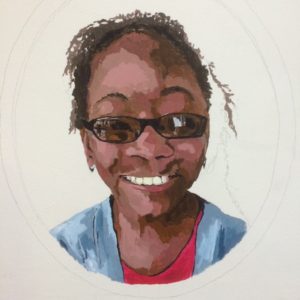 I’m getting some expert help on the mural project we are spearheading for a local non-profit. But this face I reserved to do myself. This little girl is precious, with big ideas, so she is being placed on one of the most important parts of the wall. I love her funky glasses. I love most the reflection out from her eyes and even off the plastic lenses. That was really, really fun to paint!
I’m getting some expert help on the mural project we are spearheading for a local non-profit. But this face I reserved to do myself. This little girl is precious, with big ideas, so she is being placed on one of the most important parts of the wall. I love her funky glasses. I love most the reflection out from her eyes and even off the plastic lenses. That was really, really fun to paint!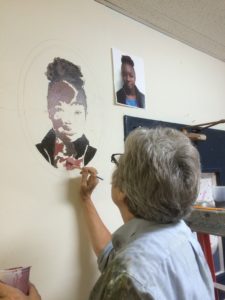 I am working on a mural for a non-profit in my community. I got to design the entire project and knew that the best idea for this refuge place for kids would be to highlight the very ones the organization serves. We took photos of 10 selected kids, then posterized them, and sketched the value divisions from each face onto the wall. Painting will start this coming week. What I hope to express here is how poignant it was to just draw their young faces, the unique smile curves, the spark in some eyes, the little crooked tooth, the sweetness on each entirely different form. These are just semblaces on a wall. But I know the real kids a little bit. I interviewed each to gain some buy-in for the ideas behind this whole project.
I am working on a mural for a non-profit in my community. I got to design the entire project and knew that the best idea for this refuge place for kids would be to highlight the very ones the organization serves. We took photos of 10 selected kids, then posterized them, and sketched the value divisions from each face onto the wall. Painting will start this coming week. What I hope to express here is how poignant it was to just draw their young faces, the unique smile curves, the spark in some eyes, the little crooked tooth, the sweetness on each entirely different form. These are just semblaces on a wall. But I know the real kids a little bit. I interviewed each to gain some buy-in for the ideas behind this whole project.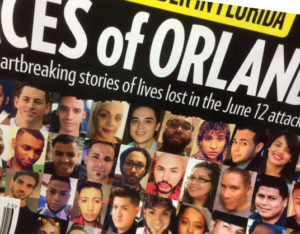 While sketching onto this wall, I was living through the news reports; faces all lined up (each completely unique) who were mowed down by a murderer’s gun in Orlando. You probably saw those images too. I did not know those folks, and so I cannot share the same sense of relationship. But the loss is incalculable for those who loved them. Such searing pain is grief! We are all robbed when even one precious soul is ripped away. Robbed and ripped and many, many left sorrowing.
While sketching onto this wall, I was living through the news reports; faces all lined up (each completely unique) who were mowed down by a murderer’s gun in Orlando. You probably saw those images too. I did not know those folks, and so I cannot share the same sense of relationship. But the loss is incalculable for those who loved them. Such searing pain is grief! We are all robbed when even one precious soul is ripped away. Robbed and ripped and many, many left sorrowing.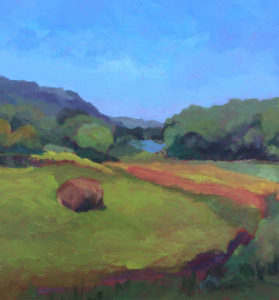 And I will use my energy instead to slice a section of a piece I painted Monday. I was at a beautiful farm owned by a woman named Ginger in a place called Goshen Valley. I was standing painting quietly next to a friend who also is suffering on the inside and doing it bravely. We took courage together and both managed to look out and to gather in some of the beauty and the glory with our brushes. That was a good day. The whole is good. But for now: just a slice, thank-you. I can be sustained with a good slice. For here’s a simple truth, easy to absorb: that which is good comes from Him (every last bit of it) and that which is not good does not.
And I will use my energy instead to slice a section of a piece I painted Monday. I was at a beautiful farm owned by a woman named Ginger in a place called Goshen Valley. I was standing painting quietly next to a friend who also is suffering on the inside and doing it bravely. We took courage together and both managed to look out and to gather in some of the beauty and the glory with our brushes. That was a good day. The whole is good. But for now: just a slice, thank-you. I can be sustained with a good slice. For here’s a simple truth, easy to absorb: that which is good comes from Him (every last bit of it) and that which is not good does not.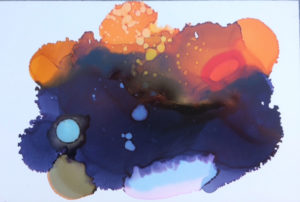 I struggle with my own voice in my work, living as I do in such a time of disintegration. I cannot make the work of my hands “say” what I hold in my heart so often. It is not my goal to be literal, but it is a desire to lift the viewer’s eyes. A friend of mine who is a photographer, grieving deeply over the death of her husband is now doing the best work of her career. We talked of this: why are we doing this work, this searching with images? Is it meaningful, is it what we “should be doing”? We got this far in our discussion: this work is an exploration into JOY. This expression is as fleeting as a sunset and as mysterious as a bird’s flight, but it is necessary, if even just for us. I have some ability to look, and to craft. Maybe through the work of my own hands others will see meaningfully also. For this, I keep on.
I struggle with my own voice in my work, living as I do in such a time of disintegration. I cannot make the work of my hands “say” what I hold in my heart so often. It is not my goal to be literal, but it is a desire to lift the viewer’s eyes. A friend of mine who is a photographer, grieving deeply over the death of her husband is now doing the best work of her career. We talked of this: why are we doing this work, this searching with images? Is it meaningful, is it what we “should be doing”? We got this far in our discussion: this work is an exploration into JOY. This expression is as fleeting as a sunset and as mysterious as a bird’s flight, but it is necessary, if even just for us. I have some ability to look, and to craft. Maybe through the work of my own hands others will see meaningfully also. For this, I keep on.